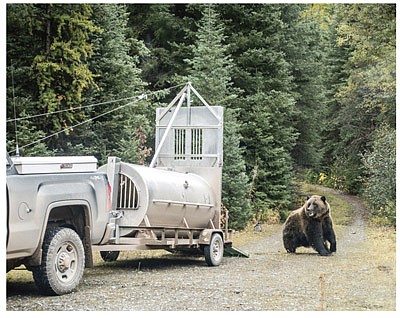Officials caught, relocated grizzly bear
Montana Fish, Wildlife and Parks (FWP) officials stand by a decision to relocate the grizzly bear that attacked a biologist last year after it recently was caught trying to get into a barn south of Libby.
“This is a kind of unprecedented situation,” said Dillon Tabish, regional information and education program manager with FWP.
Using a culvert trap, officials caught the 460-pound adult male Oct. 11. The animal had torn at the wallboards of a barn located near Bear Creek Road, trying to gain access. After affixing a tracking collar, authorities released the grizzly in a swathe of land near Poorman Creek in the Cabinet Mountains.
Removal and relocation remained an open option to officials because it was the first time this bear had gone after food in an area populated by humans, Tabish said.
But the bear a has history with people.
In May 2018, bear biologist Amber Kornak was working in the Poorman Creek area when she heard a “whuff” noise to her left.
“He was 11, 12 feet from me,” she told The Western News several months later. “I fully remember him — his whole body, his head, everything — and I turned to the right and dropped down to the ground [and] got in a bush. At that point, he was already at my back and had smacked my back and clawed my arm. I had my bear spray on my belt, so I pulled it off, got the top off and that’s when he bit down.”
Kornak succeeded in spraying the bear, which turned tail and ran off. Hiking back to safety, the biologist eventually was transported to a hospital where she was treated for her injuries.
Tabish said the 2018 encounter does not count against the bear, because it reacted naturally to a human interloper.
“It defended itself,” he said. “Whether that [individual] had been a mountain lion or a human, it was going to act the way it acted when it happened.”
When considering relocation or euthanasia, FWP officials are looking to see whether a bear has become accustomed to people or dependant on human food. Both scenarios lead to situations where grizzlies can come into conflict with people, Tabish said.
“Food conditioned bears lose their natural forage ability,” he said. “If you leave garbage out, they’ll just eat and eat there, and become dependent on that food source. That’s a public safety issue.”
And prolonged contact with humans leads to grizzlies losing their solitary disposition, Tabish said. In the wild, grizzlies eschew other animals as well as people.
“If they kind of hang around people and their homes, they lose that natural fear of humans,” Tabish said.
Once that happens, officials are forced to euthanize the animal, he said. FWP officials also move swiftly if they come across a bear that exhibits predatory behavior.
“If they start following people, we will not tolerate that,” Tabish said. “It’s the same with mountain lions. If they are out and open in the day, that displays a little bit more of a predatory nature.”
As for the grizzly caught earlier this month, Tabish said it now has a record and would face euthanasia following any further incidents.
Tabish said there’s no scientific evidence that bears develop a taste for blood after a conflict with a human. There is no indication the bear is a threat to public safety, he said.
In the same interview with The Western News in 2018, Kornak said the bear was not behaving out of the normal.
“He was just acting as bears do,” she said. “Just wondering what I am.”
To prevent conflicts between bears and humans, particularly during this part of the year when the animals are stocking up for winter, FWP officials recommend removing or mitigating attractants. That includes taking in garbage or birdseed, Tabish said. The state agency also encourages fowl owners to keep their chickens behind fencing to discourage scavenging grizzlies.
While it might be tempting to snap photos or take video of a bear that has wandered into human neighborhoods, Tabish said the animals are better served if humans ward them off. Use car alarms, lights and other methods to drive away a bear, he said.
“We’ve got grizzlies expanding, looking for food sources, so instead of folks taking photos, make it a negative experience for that bear,” he said. “We really are just trying to promote coexistence between people and wildlife, and maintain public safety. We are trying to promote acceptance of bears on the landscape, and there’s no unnecessary risk from bears that can’t be mitigated from following practical steps.”
Grizzlies remain listed as threatened under the federal Endangered Species Act. If contact with one is made or activity seen, officials encourage Cabinet-Yaak area residents to call 406-291-1320.

